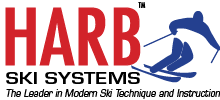[Originally posted approximately November 2013 on our old web site]
Over the last 2 weeks I've worked with a variety of skiers, from junior racers to race parents to PMTS regulars. I've been reminded about the differences between "tipping" and "tipped"...
Tipping: an ongoing movement of the feet and ankles throughout the arc of the turn; raising the arch of the inside foot more and more throughout the arc of the turn.
vs.
Tipped: tipping the feet at the beginning of the turn; riding the edges through the rest of the turn without actively tipping the feet any further.
It can be hard to tell the difference, especially if you are first learning how to tip the feet. Because we ski on a hill, as the skis curve through a turn they will automatically arrive at a higher edge angle relative to the snow. Take a ski and hold it flat on the slope as you aim it straight downhill. If you rotate the ski 90 degrees like a compass needle until it points across the hill toward the side of the trail, without any tipping whatsoever it will now have an edge angle equal to the angle of the slope. If the ski is attached to a skier who leans slightly uphill as the ski aims across the slope, then the ski will achieve an edge angle greater than the angle of the hill. "Voila!" the skier thinks, "I must be tipping!" Actually, in this scenario there is no tipping. Many skiers spend their entire time on the slopes achiving minimal ski performance because they ski without any tipping of the feet. The skis slip sideways and it's hard to make short turns.
The PMTS enthusiast knows that tipping the feet -- actively rolling the feet from one side to the other to make the skis roll on edge -- will help them to ski better. Any kind of tipping input of the feet, especially in turn transition, makes the skis turn more easily and controls speed better. Tipping is one component of the Phantom Move that makes it so effective. Once a skier learns the "lift and tilt" initiation of a turn, it's easy to get stuck at that level of performance. The skier does tip the feet to start the turn, but after that there is no further rolling of the feet on edge. This is what I called "tipped" rather than "tipping". The performance of the skis is far better than in the first scenario -- they turn more quickly and more easily, the turns become tighter, and speed control is improved. However, another level of performance is still available...
With more focus, the PMTS skier learns to increase the angle of the feet to the snow as the skis curve through the turn: "tipping". You can think of this in different ways... "start, more, most"; "small, medium, large"; "one, two, three". Each set of words represents the tipping angle of the feet from beginning through the middle to near the end of the turn.
Try this in bare feet as you sit on a chair: start with the feet flat on the floor; tip them to the right by lifting up on the arch/big-toe side of the right foot and the outside edge/little-toe side of the left foot. Emphasize the foot that tips toward its outside edge, as this will have the best effect on snow. Start with a small gap under the lifted edge of each foot (maybe 1/8" or 2 mm), then double it (1/4" or 4 mm), then triple it. Try keeping the knees in place and the shins vertical, at least as you start the tipping. This ensures that you are tipping the feet, not just moving the upper legs. Repeat to the left.
Try it again while wearing your ski boots. With tight boots, any tipping of the feet will result in the boots tipping on edge - that's the idea! However, you still want to lift the edges of the feet just as you did in bare feet. Tipping the feet moves the ankles into contact with the ski boot; merely leaning the shins back and forth does not. Again, do it as three stages: "start, more, most"; "lift, double, triple". Practice it to both sides.
Now, make some turns on easy terrain. Use your feet exactly as you have practiced, tipping from side to side in three stages. Remember to emphasize the inside foot, the one that tips to its outside or little-toe edge. The more that you continue tipping through the turn, the tighter the turn you will achieve, the better the speed control, and potentially the more you will carve the snow.
Want to learn and practice more?
Read more about tipping in Chapter 2 of our book Essentials of Skiing.
Practice tipping with our full-length video Essentials of Skiing #1 - Tipping (DVD or downloadable eVideo)
Watch Harald as he demonstrates tipping on snow in this YouTube video...



